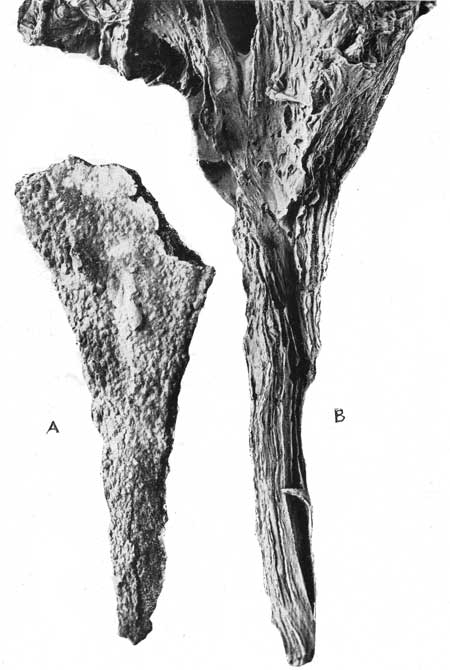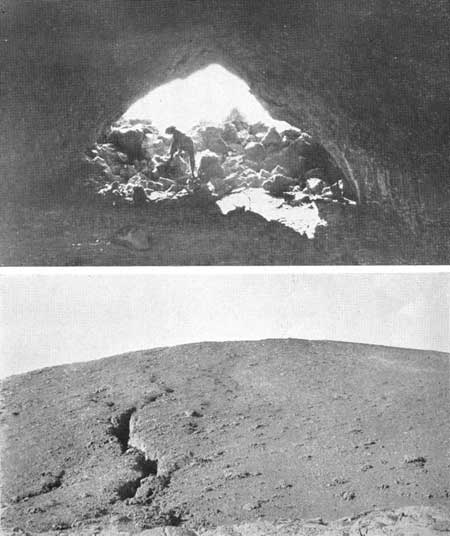
|
Idaho Bureau of Mines and Geology Bulletin
Craters of the Moon National Monument, Idaho |
TREE MOLDS.
Tree molds exist in certain lava flows in the Craters of the Moon where the lava flowed slowly and at the right temperature into a forest. When the charred or partly burned wood rotted away the hole formed a perfect mold of the part of the upright tree and the branches that were buried by the lava. The tree molds range in diameter from a few inches to 3 feet and are easily distinguished from other holes in the lava because they retain the form of the tree and its branches. Many of them are 10 to 20 feet deep, the depth depending upon the thickness of the lava that surrounded the tree and the amount of rock or cinders that have fallen or blown into the mold since it was formed. The explanation why molten lava does not completely obliterate a tree is apparent to one who understands the characteristics of lava flows. It is possible to walk on pahoehoe a short time after it crusts over and while there is still molten lava beneath, because a few inches of the lava crust cools rapidly and is sufficient to prevent any great amount of heat from escaping. This fact is easily demonstrated by applying a hot blast from a blacksmith's forge on one side of a 4-inch crust of lava. Moreover, liquid lava at or near the temperature of solidification requires very little time to become a rock that is a poor conductor of heat. Thus within a few minutes lava that surrounds a tree becomes a shell of solid rock. Moreover, the burning started by the hot lava creates an air space or chamber between the tree and the mold which accelerates the cooling of the lava. The cooling process is further aided by the steam emitted from the sap of the tree. The writer saw trees in Hawaii which two years after they had been partly buried by lava had their upper portions uncharred and had dead leaves clinging to the branches. There is much less chance for the formation of a mold from a dead tree, for it burns so rapidly that it may be completely destroyed while the lava is still plastic.

|
| PLATE XIII—A lava stalactite from the under surface of the crust of a pahoehoe flow (B), in contrast to a lava stalactite from the roof of a lava tunnel (A). Natural size. |
Most of the vertical tree molds do not preserve charcoal impressions, but in some places where the tops of the trees fell on plastic lava the impression of the charred log and the delicate grain of the wood had been preserved. In places the lava was soft enough or was rendered plastic enough by the steam from the burning wood to flow into the checks or shrinkage cracks in the charred surface of the log, forming a checker pattern that is easily mistaken for bark impressions. Practically all the tree molds in the Monument were examined, but not one was found that showed bark impressions. The principal localities where tree molds have been found are given on page 56.
There are two kinds of tree molds in the area. Those of one kind, called lava trees, are common on Trench Mortar Flat south east of Big Craters Butte. These trees rise 1 to 5 feet above the lava surface. Lava trees are formed in the same manner as the tree molds just described but in localities favorable to the draining away of part of the lava flow, or they are due to trees being buried by spatter from a spatter vent. There are in Hawaii lava trees 40 feet high which consist of thin shells of lava surrounding charred remnants of trees. The other kind is represented by the tree molds of simple type that extend downward into the lava flow. The top of the tree is sometimes found molded near-by on the lava surface.

|
|
PLATE XIV—A.—The Bridge of the Moon, showing the graceful arch
of a lava tunnel. Photograph by H. T. Stearns. B.—Dark yawning fissures break the barren surface of Broken Top. Note the flattened bombs near-by. Photograph by H. T. Stearns. |
During the eruption of Etna in 1865 the lava entered a pine forest. The results of this invasion are described by Reclus1 as follows:
"Sheaths of solidified lava were surrounding the trunks of pines, and thus showing the height to which the current of molten stone had reached. * * * Below the escarpments of the Frumento, the torrent, which was there retarded in its progress, had not contented itself with bathing for a moment the trunks of the forest trees but had laid them low. Great trunks of trees, broken down by the lava, lay stretched in disorder on the uneven bed of the stream, and, although they were only separated from the molten matter by a crust a few inches thick, numbers of them were still clothed with their bark; several had even preserved their branches. At the edge of the cheire2 some pine trees, which had perhaps been preserved from the fire by their moisture being converted by heat into a kind of coating by steam, were surrounded by a wall of heaped-up lava, and their foliage still continued green; it could not yet be ascertained if the sources of the sap had perished in their roots. In some places rows of firs very close together were sufficient to change the direction of the flow and to cause a lateral deviation."
1Reclus, Elisee, The Earth, vol. 2, p. 495, New York, G. P. Putnam & Sons, 1871.
2French for aa lava.
| <<< Previous | <<< Contents >>> | Next >>> |
id/1928-13/sec8.htm
Last Updated: 28-Mar-2006